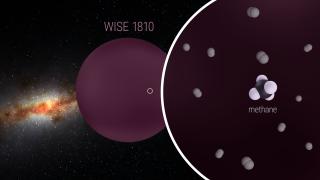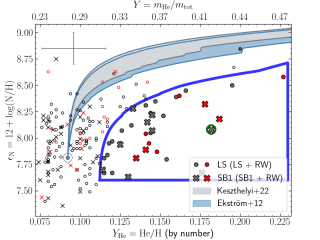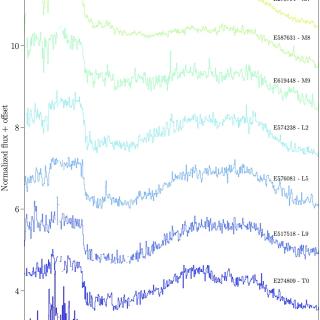Utilizando modelos semiempíricos de los espectros de fotoabsorción de varios fullerenos individuales (C_80, C_240, C_320 y C_540) predecimos transiciones en la región de la banda difusa más intensa del medio interestelar a 4430 A que podrían explicar su origen, hasta ahora desconocido. Estos modelos también presentan una alta densidad de transiciones en el ultravioleta que reproducen el denominado "bump" a 2175 A en la curva de extinción del medio interestelar (Iglesias-Groth 2004). Parece que los fullerenos podrían ser responsables de dos de los mayores rasgos de la absorción interestelar. Haciendo uso de las secciones eficaces teóricas y de los datos empíricos estimamos que la abundancia de fullerenos es de 0.05 moléculas por millón de átomos de hidrógeno en regiones del medio interestelar con índice de exceso de color E(B-V)~ 1.0.
Advertised on
It may interest you
-
 WISEA J181006.18-101000.5 (WISE1810) is the nearest metal-poor ultracool dwarf to the Sun. It has a low effective temperature and has been classified as an extreme early-T subdwarf. However, methane--the characteristic molecule of the spectral class T--was not detected in the previous low-resolution spectrum. Constraining the metallicity--the abundance of elements heavier than helium-- of these cold objects has been a challenge. Using the 10.4 m Gran Telescopio Canarias, the largest optical-infrared telescope in the world, we collected a high-quality near-infrared intermediate-resolutionAdvertised on
WISEA J181006.18-101000.5 (WISE1810) is the nearest metal-poor ultracool dwarf to the Sun. It has a low effective temperature and has been classified as an extreme early-T subdwarf. However, methane--the characteristic molecule of the spectral class T--was not detected in the previous low-resolution spectrum. Constraining the metallicity--the abundance of elements heavier than helium-- of these cold objects has been a challenge. Using the 10.4 m Gran Telescopio Canarias, the largest optical-infrared telescope in the world, we collected a high-quality near-infrared intermediate-resolutionAdvertised on -
 There is increasing evidence that single-star evolutionary models are unable to reproduce all of the observational properties of massive stars. Binary interaction has emerged as a key factor in the evolution of a significant fraction of massive stars. In this study, we investigate the helium (Y(He)) and nitrogen surface abundances in a comprehensive sample of 180 Galactic O-type stars with projected rotational velocities of ≤150 km/s. We found a subsample (~20% of the total, and ~80% of the stars with Y(He) ≥ 0.12) with a Y(He) and nitrogen abundance combined pattern that is unexplainable byAdvertised on
There is increasing evidence that single-star evolutionary models are unable to reproduce all of the observational properties of massive stars. Binary interaction has emerged as a key factor in the evolution of a significant fraction of massive stars. In this study, we investigate the helium (Y(He)) and nitrogen surface abundances in a comprehensive sample of 180 Galactic O-type stars with projected rotational velocities of ≤150 km/s. We found a subsample (~20% of the total, and ~80% of the stars with Y(He) ≥ 0.12) with a Y(He) and nitrogen abundance combined pattern that is unexplainable byAdvertised on -
 The Near-Infrared Spectrometer and Photometer (NISP) on board the Euclid space mission has obtained near-infrared (NIR) spectra of millions of objects, including hundreds of ultracool dwarfs (UCDs). Euclid observations retrieve images and slitless spectra simultaneously. This observing mode marks a new era in the discovery of new objects, such as L- and T-type dwarfs, which can be found from direct identification through the H2O and CH4 absorption bands. NISP spectral resolution (R ∼ 450) is enough to classify the objects by the spectral type using known standard templates. Q1 provided moreAdvertised on
The Near-Infrared Spectrometer and Photometer (NISP) on board the Euclid space mission has obtained near-infrared (NIR) spectra of millions of objects, including hundreds of ultracool dwarfs (UCDs). Euclid observations retrieve images and slitless spectra simultaneously. This observing mode marks a new era in the discovery of new objects, such as L- and T-type dwarfs, which can be found from direct identification through the H2O and CH4 absorption bands. NISP spectral resolution (R ∼ 450) is enough to classify the objects by the spectral type using known standard templates. Q1 provided moreAdvertised on